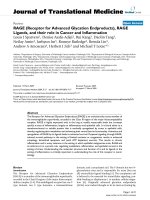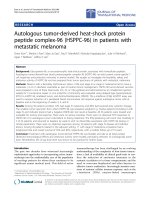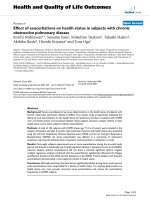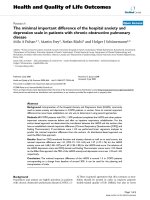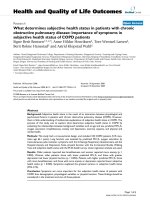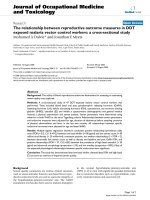báo cáo hóa học: " The minimal important difference of the hospital anxiety and depression scale in patients with chronic obstructive pulmonary disease" pot
Bạn đang xem bản rút gọn của tài liệu. Xem và tải ngay bản đầy đủ của tài liệu tại đây (236.94 KB, 6 trang )
BioMed Central
Page 1 of 6
(page number not for citation purposes)
Health and Quality of Life Outcomes
Open Access
Research
The minimal important difference of the hospital anxiety and
depression scale in patients with chronic obstructive pulmonary
disease
MiloAPuhan*
1
, Martin Frey
2
, Stefan Büchi
3
and Holger J Schünemann
4,5
Address:
1
Horten Centre for patient-oriented research, University Hospital of Zurich, Switzerland,
2
Klinik Barmelweid, Barmelweid, Switzerland,
3
Department of Psychiatry, University Hospital of Zurich, Switzerland,
4
Clarity Research Group, Department of Clinical Epidemiology and
Biostatistics, McMaster University, Hamilton, Ontario, Canada and
5
Department of Epidemiology, Italian National Cancer Institute Regina Elena,
Rome, Italy
Email: Milo A Puhan* - ; Martin Frey - ; Stefan Büchi - ;
Holger J Schünemann -
* Corresponding author
Abstract
Background: Interpretation of the Hospital Anxiety and Depression Scale (HADS), commonly
used to assess anxiety and depression in COPD patients, is unclear. Since its minimal important
difference has never been established, our aim was to determine it using several approaches.
Methods: 88 COPD patients with FEV
1
≤ 50% predicted completed the HADS and other patient-
important outcome measures before and after an inpatient respiratory rehabilitation. For the
anchor-based approach we determined the correlation between the HADS and the anchors that
have an established minimal important difference (Chronic Respiratory Questionnaire [CRQ] and
Feeling Thermometer). If correlations were ≥ 0.5 we performed linear regression analyses to
predict the minimal important difference from the anchors. As distribution-based approach we
used the Effect Size approach.
Results: Based on CRQ emotional function and mastery domain as well as on total scores, the
minimal important difference was 1.41 (95% CI 1.18–1.63) and 1.57 (1.37–1.76) for the HADS
anxiety score and 1.68 (1.48–1.87) and 1.60 (1.38–1.82) for the HADS total score. Correlations of
the HADS depression score and CRQ domain and Feeling Thermometer scores were < 0.5. Based
on the Effect Size approach the MID of the HADS anxiety and depression score was 1.32 and 1.40,
respectively.
Conclusion: The minimal important difference of the HADS is around 1.5 in COPD patients
corresponding to a change from baseline of around 20%. It can be used for the planning and
interpretation of trials.
Background
Depression and anxiety are highly prevalent in patients
with chronic obstructive pulmonary disease (COPD). [1-
3] There is general agreement that this common co-mor-
bidity should be treated in order to improve patients'
health-related quality of life (HRQL) but also to lower
Published: 2 July 2008
Health and Quality of Life Outcomes 2008, 6:46 doi:10.1186/1477-7525-6-46
Received: 21 January 2008
Accepted: 2 July 2008
This article is available from: />© 2008 Puhan et al; licensee BioMed Central Ltd.
This is an Open Access article distributed under the terms of the Creative Commons Attribution License ( />),
which permits unrestricted use, distribution, and reproduction in any medium, provided the original work is properly cited.
Health and Quality of Life Outcomes 2008, 6:46 />Page 2 of 6
(page number not for citation purposes)
health care consumption [4-6] A number of treatment
options are available such as cognitive behavioral thera-
pies[7], antidepressants[8] or physical exercise[9] and
there is an increasing number of randomised trials inves-
tigating these treatments.
The Hospital Anxiety and Depression Scale (HADS) is a
widely used instrument to assess symptoms of depression
and anxiety. It is not a tool to diagnose mood disorders
but it has proofed to be a reliable, valid and responsive
instrument to assess the severity of symptoms of mood
disorders.[10] The self-administration and short comple-
tion time makes the HADS an attractive instrument for
use in trials. It is, however, difficult to interpret treatment
effects because the minimal important difference of the
HADS it is not known[11]
The concept of the minimal important difference the
smallest difference in the outcome of interest that
informed patients or their proxies perceive as important
and that may lead to a change in the management[12],
has become the standard approach to interpret the clinical
relevance of treatment effects[13,14] For example, the
minimal important difference of the Chronic Respiratory
Questionnaire (CRQ) has been established to be 0.5
points on the Likert-type scale from 1 to 7[15] Meta-anal-
yses of randomised trials on respiratory rehabilitation
show treatment effects between 0.5 and 1.0 on the CRQ
thus exceeding the minimal important difference of 0.5
points and providing a patient-important benefit for a
majority of patients.[16]
In order to understand how to interpret HADS scores we
conducted an analysis to establish the minimal important
difference of the HADS in COPD patients. Since a single
approach is not sufficient we used anchor- and distribu-
tion-based methods to determine the minimal important
difference of the HADS.[17]
Methods
Study and patients
We used the data of a randomized trial that compared dif-
ferent exercise modalities during an inpatient rehabilita-
tion[18] COPD patients with a FEV1 ≤ 50% predicted
(stage III-IV according to the Global Initiative for Chronic
Obstructive Lung Disease criteria) and German as first or
daily language followed an inpatient respiratory rehabili-
tation with a duration of approximately 3 weeks that
included a median number of 13 exercise sessions and
that was followed by individually prescribed home-based
exercise (median number of total exercise sessions of 22
following after five weeks). The rehabilitation program
also included patient education, breathing therapies and
optimisation of medical therapy. We excluded patients
with cardiovascular, musculoskeletal or neurological dis-
orders only if physical exercise was not possible due to
these co-morbidities. The study took place in a public
rehabilitation clinic in Switzerland (Klinik Barmelweid,
Aargau). The responsible ethics committee approved the
study protocol and all study participants provided written
informed consent.
HADS
Patients completed the self-administered and validated
German version of the HADS[19] The HADS measures
depression and generalised anxiety in in- and outpatients
and in community settings. It contains 14 statements
describing symptoms of depression and anxiety (for
example "I feel tense and irritable"). Response options for
each question range from 0 to 3 and ask patients about
their agreement with the statements or how often they
apply (for example "most of the time, often, from time to
time or not at al"). There are seven statements for each
depression and anxiety. Domain scores range from 0 (no
depression or anxiety) to 21 and following the standard
convention scores ≥ 11 indicate a probable clinical diag-
nosis of depression or anxiety.
Patient-important outcomes used as anchors
We used the CRQ and the Feeling Thermometer as poten-
tial anchors to determine the minimal important differ-
ence of the HADS. The CRQ is a widely used instrument
in respiratory rehabilitation and measures dyspnea,
fatigue, emotional functioning and coping with
COPD.[20] Domain and total scores are presented on a
Likert-type scale from 1 (most severe impairment) to 7
(no impairment). We used the self-administered German
version[21] with standardized dyspnea questions[15] The
Feeling Thermometer is a validated preference-based
instrument with marked intervals from 0 (worst health
state = dead) to 100 (perfect health) and it is increasingly
used as a global estimate of the effect of interventions,
including respiratory rehabilitation[22,23]
Statistical analysis
For the anchor based approach we followed the within-
patient anchor based method.[23] With this approach the
minimal important difference of the instrument of inter-
est (HADS) is estimated based on anchors (CRQ and Feel-
ing Thermometer) for which the minimal important
difference has been established before. An equation is
derived based on linear regression analysis where the
instrument of interest is the dependent and the anchors
the independent variable. Using the equation one can
estimate the minimal important difference of the instru-
ment of interest.
In our analysis, we first assessed the correlation between
the anchors (CRQ and Feeling Thermometer) and the
HADS domain and total score. We decided to use linear
Health and Quality of Life Outcomes 2008, 6:46 />Page 3 of 6
(page number not for citation purposes)
regression analyses with HADS domain and total scores as
the dependent and the anchors as independent variables
if correlation coefficients exceeded 0.5.[23] Using the
regression equation and the minimal important differ-
ence of the anchors (0.5 points for the CRQ[15] and 8
points for the FT[23]) we estimated the minimal impor-
tant difference of the HADS domain and total scores.
We used the Effect Size approach as distribution-based
method based. The Effect Size approach expresses treat-
ment effects as standard deviation (SD) units of change
scores (difference between baseline and follow-up). 0.5
SD units represent a moderate effect size and investigators
usually consider this estimate to correspond to the mini-
mal important difference[24] We conducted all analyses
using SPSS for Windows (version 12).
Results
We included 88 patients with complete data in this analy-
sis. 10 patients did not complete the HADS at the follow-
up after five weeks because they did not return to the study
center for the follow-up assessment or because they did
not return the questionnaire by mail. They did not differ
from patients included in the analyses. The mean age of
included patients was 68.7 (SD 8.9) years, 59 (67.0%)
were males, patients had moderate to very severe COPD
with a mean FEV
1
in % predicted was 34.3% (SD 8.2),
mean years since diagnosis was 9.3 years (SD 7.3) and
mean number of pack years was 52.3 (SD 28.7) years. 49
(55.7%) had suffered from an exacerbation in the previ-
ous eight weeks and 49 (55.7%) had cardiovascular co-
morbidity.
The mean HADS depression score at baseline was 7.63
(SD 3.9) and 19 (21.6%) patients had scores ≥ 11. For the
HADS anxiety domain, mean score was 7.03 (SD 4.0) and
20 (22.7%) patients had scores ≥ 11. Table 1 shows the
changes from baseline to follow-up for HADS, CRQ and
Feeling Thermometer scores and the correlations between
outcomes. The change scores for the CRQ and Feeling
Thermometer both exceeded the threshold of their mini-
mal important difference (0.5 and 8 points, respectively).
Correlations were highest between the CRQ emotional
function domain and HADS scores and lowest between
the CRQ dyspnea and Feeling Thermometer and the
HADS scores. We found strong correlations (≥ 0.5)
between the HADS anxiety domain and the CRQ emo-
tional function and mastery domains and between the
HADS total score and the CRQ emotional function and
total score. None of the correlations between the HADS
depression score and anchors were ≥ 0.5.
Table 2 shows the minimal important difference estimates
based on the anchor-based methods. The minimal impor-
tant difference estimates were consistent across the four
regression models and between 1.41 (95% CI 1.18–1.63)
and 1.68 (1.48–1.87). The minimal important differences
were a little lower for the distribution-based method.
Based on the Effect Size approach the minimal important
difference was 1.40 for the HADS depression score, 1.32
for the HADS anxiety score and 1.17 for the HADS total
score.
Discussion
This analysis showed that the minimal important differ-
ence of the HADS is approximately 1.5 points in COPD
patients. Investigators and those interpreting clinical
research can use this minimal important difference to
determine whether treatment effects are in a range that is
important to patients and would indicate a positive effect.
A strength of this study is the use of different approaches
to establish the minimal important difference as none of
the single approaches is without limitations.[17] In addi-
tion, we used a rigorous criterion for the anchors (correla-
tions had to be ≥ 0.5) because an external anchor provides
a valid estimate of the minimal important difference only
if the correlation between the target instrument and the
anchor is sufficiently high.[17] As a consequence of corre-
lations below 0.5, we could not use the anchor-based
Table 1: Changes
#
in HADS and CRQ and Feeling Thermometer scores and correlations
‡
of changes
HADS depression
domain
HADS anxiety
domain
HADS total score
Changes from
baseline to follow-up
-2.44 (2.79) -2.02 (2.65) -2.23 (2.34)
CRQ dyspnea 1.25 (1.17) -0.24 -0.17 -0.24
CRQ fatigue 0.94 (1.25) -0.43 -0.37 -0.46
CRQ emotional function 0.96 (1.07) -0.42 -0.55 -0.56
CRQ mastery 0.94 (1.28) -0.28 -0.51 -0.45
CRQ total 1.02 (0.99) -0.41 -0.48 -0.51
Feeling Thermometer 11.16 (15.82) -0.23 -0.21 -0.25
#
Values for changes are means (standard deviation).
‡
Pearson correlation coefficients. Values in bold indicate sufficiently high correlations for using the anchor based method (linear regression analysis)
Health and Quality of Life Outcomes 2008, 6:46 />Page 4 of 6
(page number not for citation purposes)
approach to estimate the minimal important difference of
the HADS depression score. Also, the Feeling Thermome-
ter could not be used at all. Correlations with HADS
domain and total scores were surprisingly low compared
with those observed in earlier studies.[22] A possible
explanation for lower correlations is that inclusion criteria
for randomised trials as ours are usually stricter than those
of non-randomised studies, which is the common study
design for validation studies. Smaller between-person dif-
ferences, as a consequence of stricter inclusion criteria,
may have a substantial (negative) impact on correlation
coefficients.
Anchor-based methods yielded somewhat higher mini-
mal important difference estimates than the distribution-
based method. Differences between the methods do not
appear to be significant as the distribution-based esti-
mates were within 95% confidence intervals of the
anchor-based estimates. A likely explanation for the lower
estimates is that we used only one study. Distribution
based methods tend to underestimate the minimal impor-
tant difference if based on single studies because distribu-
tions are narrower or SD smaller, respectively, as a
consequence of eligibility criteria. Therefore, we would
welcome further analyses that, optimally, pool data from
different studies in order to include a population that is as
broad as possible.
Awareness that anxiety and depression are common co-
morbidities in chronic disease has risen over the last dec-
ade [1-3] But recent systematic reviews of common treat-
ments such as cognitive behavioral therapies[7],
antidepressants[8] or physical exercise[9] show that evi-
dence is still scarce. Few trials on physical exercise used,
for example, an instrument for symptoms of depression
or anxiety. Only one large trial.[25] used the HADS so far.
It found, after six weeks of rehabilitation in patients with
COPD, reductions of 1.3 points (95% CI 0.6–2.4) for anx-
iety and 2.1 points (95% CI 1.3–2.8) for depression
scores. Thus for anxiety, the effect might just be of border-
line importance to patients whereas the majority of
patients perceived a benefit for depressive symptoms. For
any treatment of depression and anxiety in diseases such
as COPD evidence is still lacking to provide strong recom-
mendations. However, the treatment of depression in dis-
ease such as COPD will be increasingly important. In
trials using the HADS the MID estimate of 1.5 points will
play an important role to interpret treatment effects.
The minimal important difference also plays an impor-
tant role to determine sample sizes of trials. It provides the
ideal base for specifying the patient-important difference
that investigators want to detect. To find a difference of
1.5 points at a significance level of 0.05 and with a power
of 80% and assuming a SD of 4 points as observed in our
study, investigators need to enroll 112 patients in each
group. If a power of 90% is desired as it may be for equiv-
alence trials, 150 patients would be needed in each group.
The CIs around the minimal important difference of 1.5
should not be used to determine sample sizes of trials and
to make treatment decisions without the understanding
that the point estimate of 1.5 is the best estimate of the
minimal important difference and that the limits of the
CIs are sample size dependent. Since this sample is rela-
tively small, the CIs relatively are wide and, thus, attention
must be paid to this issue. We suggest that the point esti-
mate of 1.5 is used as best estimate.
We do not know whether the minimal important differ-
ence of 1.5 generalizes to patients with other diseases.
Patients included in our study might, however, represent
patients with advanced chronic disease because mean
HADS anxiety (7.03) and depression scores (7.63) were in
the range commonly encountered in patients with chronic
disease.[26,27] A change of 1.5 points corresponds
approximately to a 20% change from these baseline
scores. In patients with substantially lower or higher
scores, the minimal important difference might be smaller
or larger, respectively, but it would be important to know
whether a 20% change would represent the minimal
Table 2: Anchor-based method to determine the minimal important difference of the HADS
Regression equation Corresponding to 0.5 change in CRQ
score (95% confidence interval*)
Change in HADS 0.73 + 1.35*CRQemotional function, r
2
= 0.30 1.41 (1.18–1.63)
anxiety score 1.04 + 1.05*CRQmastery, r
2
= 0.26 1.57 (1.37–1.76)
Change in HADS total score 1.07 + 1.21*CRQemotional function, r
2
= 0.31 1.68 (1.48–1.87)
1.00 + 1.20*CRQtotal, R
2
= 0.26 1.60 (1.38–1.82)
Constant and coefficients correlations multiplied by -1 to facilitate interpretation.
* The 95% confidence intervals around the minimal important difference should not be used to make treatment decisions or develop trials without
the understanding that the point estimate is the best estimate of the minimal important difference and that the limits of the 95% confidence intervals
are sample size dependent. Since this sample is relatively small, the 95% confidence intervals are wide and, thus, attention must be paid to this issue.
The point estimate should be used as best estimate.
Health and Quality of Life Outcomes 2008, 6:46 />Page 5 of 6
(page number not for citation purposes)
important difference as well. Other studies should inves-
tigate the minimal important difference of the HADS in
order to interpret and plan studies outside of COPD.
Conclusion
Our analysis shows that the minimal important of the
HADS is around 1.5 points in COPD patients correspond-
ing to a change from baseline of around 20%. This esti-
mate is informed by both anchor- and distribution-based
methods. The minimal important difference informs cli-
nicians to interpret the importance of treatment effects on
depression and anxiety in patients with COPD and pro-
vides an evidence base for sample size calculations in tri-
als where investigators use the HADS as the primary
outcome.
Authors' contributions
MP participated in the design of the study, performed the
statistical analysis and drafted the manuscript. MF partic-
ipated in the design of the study, collection of the data
and revised the manuscript. SB revised the manuscript.
HJS participated in the design of the study, performed the
statistical analysis and revised the manuscript. All authors
read and approved the final manuscript.
Conflict of interest statement
Holger Schünemann is one of the developers of the CRQ-
SAS. HJS is editor in chief of HQLO and Milo Puhan Asso-
ciate Editor. The article underwent regular blind peer
review.
Acknowledgements
Milo A. Puhan is supported by a career award of the Swiss National Science
Foundation (# 3233B0/115216/1)
Holger Schünemann is supported by a European Commission: The human
factor, mobility and Marie Curie Actions. Scientist Reintegration Grant
(IGR 42192).
References
1. Yohannes AM, Baldwin RC, Connolly MJ: Depression and anxiety
in elderly outpatients with chronic obstructive pulmonary
disease: prevalence, and validation of the BASDEC screening
questionnaire. International journal of geriatric psychiatry 2000,
15(12):1090-1096.
2. van Manen JG, Bindels PJ, Dekker FW, CJ IJ, van der Zee JS, Schade E:
Risk of depression in patients with chronic obstructive pul-
monary disease and its determinants. Thorax 2002,
57(5):412-416.
3. Kunik ME, Roundy K, Veazey C, Souchek J, Richardson P, Wray NP,
Stanley MA: Surprisingly high prevalence of anxiety and
depression in chronic breathing disorders. Chest 2005,
127(4):1205-1211.
4. Society AT, Society ER: Standards for the diagnosis and treat-
ment of patients with chronic obstructive pulmonary dis-
ease. [ />index.html].
5. Dahlen I, Janson C: Anxiety and depression are related to the
outcome of emergency treatment in patients with obstruc-
tive pulmonary disease. Chest 2002, 122(5):1633-1637.
6. FitzGerald JM, Haddon JM, Bradly-Kennedy C, Kuramoto L, Ford GT:
Resource use study in COPD (RUSIC): a prospective study
to quantify the effects of COPD exacerbations on health
care resource use among COPD patients. Can Respir J 2007,
14(3):145-152.
7. Coventry PA, Gellatly JL: Improving outcomes for COPD
patients with mild-to-moderate anxiety and depression: A
systematic review of cognitive behavioural therapy. Br J
Health Psychol 2007.
8. Lacasse Y, Beaudoin L, Rousseau L, Maltais F: Randomized trial of
paroxetine in end-stage COPD. Monaldi archives for chest disease
= Archivio Monaldi per le malattie del torace / Fondazione clinica del lavoro,
IRCCS [and] Istituto di clinica tisiologica e malattie apparato respiratorio,
Universita di Napoli, Secondo ateneo 2004, 61(3):140-147.
9. Coventry PA, Hind D: Comprehensive pulmonary rehabilita-
tion for anxiety and depression in adults with chronic
obstructive pulmonary disease: Systematic review and
meta-analysis. Journal of psychosomatic research 2007,
63(5):551-565.
10. Snaith RP: The Hospital Anxiety And Depression Scale. Health
and quality of life outcomes 2003, 1(1):29.
11. Lee JS, Hurley MJ, Carew D, Fisher R, Kiss A, Drummond N: A ran-
domized clinical trial to assess the impact on an emergency
response system on anxiety and health care use among older
emergency patients after a fall. Acad Emerg Med 2007,
14(4):301-308.
12. Schunemann HJ, Guyatt GH: Commentary goodbye M(C)ID!
Hello MID, where do you come from? Health services research
2005, 40(2):593-597.
13. Revicki DA, Cella D, Hays RD, Sloan JA, Lenderking WR, Aaronson
NK: Responsiveness and minimal important differences for
patient reported outcomes. Health and quality of life outcomes
2006, 4:70.
14. Wise RA, Brown CD: Minimal clinically important differences
in the six-minute walk test and the incremental shuttle walk-
ing test. Copd 2005, 2(1):125-129.
15. Schunemann HJ, Puhan M, Goldstein R, Jaeschke R, Guyatt GH:
Measurement properties and interpretability of the Chronic
respiratory disease questionnaire (CRQ). Copd 2005,
2(1):81-89.
16. Lacasse Y, Brosseau L, Milne S, Martin S, Wong E, Guyatt GH, Gold-
stein RS: Pulmonary rehabilitation for chronic obstructive
pulmonary disease. CochraneDatabaseSystRev 2004:CD003793.
17. Guyatt GH, Osoba D, Wu AW, Wyrwich KW, Norman GR: Meth-
ods to explain the clinical significance of health status meas-
ures. Mayo Clinic proceedings 2002, 77(4):371-383.
18. Puhan MA, Busching G, Schunemann HJ, VanOort E, Zaugg C, Frey M:
Interval versus continuous high-intensity exercise in chronic
obstructive pulmonary disease: a randomized trial. Annals of
internal medicine 2006, 145(11):816-825.
19. Herrmann C: International experiences with the Hospital
Anxiety and Depression Scale a review of validation data
and clinical results. Journal of psychosomatic research 1997,
42(1):17-41.
20. Guyatt GH, Berman LB, Townsend M, Pugsley SO, Chambers LW: A
measure of quality of life for clinical trials in chronic lung dis-
ease. Thorax 1987, 42(10):773-778.
21. Puhan MA, Behnke M, Frey M, Grueter T, Brandli O, Lichtenschopf A,
Guyatt GH, Schunemann HJ: Self-administration and inter-
viewer-administration of the German Chronic Respiratory
Questionnaire: instrument development and assessment of
validity and reliability in two randomised studies. Health and
quality of life outcomes 2004, 2(1):1.
22. Puhan MA, Behnke M, Devereaux PJ, Montori VM, Braendli O, Frey
M, Schunemann HJ: Measurement of agreement on health-
related quality of life changes in response to respiratory
rehabilitation by patients and physicians a prospective
study. Respir Med 2004, 98(12):1195-1202.
23. Schunemann HJ, Griffith L, Jaeschke R, Goldstein R, Stubbing D, Guy-
att GH: Evaluation of the minimal important difference for
the feeling thermometer and the St. George's Respiratory
Questionnaire in patients with chronic airflow obstruction.
Journal of Clinical Epidemiology 2003, 56(12):1170-1176.
24. Walters SJ, Brazier JE: What is the relationship between the
minimally important difference and health state utility val-
ues? The case of the SF-6D. Health and quality of life outcomes
2003, 1(1):4.
Publish with BioMed Central and every
scientist can read your work free of charge
"BioMed Central will be the most significant development for
disseminating the results of biomedical research in our lifetime."
Sir Paul Nurse, Cancer Research UK
Your research papers will be:
available free of charge to the entire biomedical community
peer reviewed and published immediately upon acceptance
cited in PubMed and archived on PubMed Central
yours — you keep the copyright
Submit your manuscript here:
/>BioMedcentral
Health and Quality of Life Outcomes 2008, 6:46 />Page 6 of 6
(page number not for citation purposes)
25. Griffiths TL, Burr ML, Campbell IA, Lewis-Jenkins V, Mullins J, Shiels
K, Turner-Lawlor PJ, Payne N, Newcombe RG, Ionescu AA, Thomas
J, Tunbridge J: Results at 1 year of outpatient multidisciplinary
pulmonary rehabilitation: a randomised controlled trial. Lan-
cet 2000, 355(9201):362-368.
26. Pallant JF, Bailey CM: Assessment of the structure of the Hospi-
tal Anxiety and Depression Scale in musculoskeletal
patients. Health and quality of life outcomes 2005, 3:82.
27. Wang W, Lopez V, Martin CR: Structural ambiguity of the Chi-
nese version of the Hospital Anxiety and Depression Scale in
patients with coronary heart disease. Health and quality of life
outcomes 2006, 4:6.
